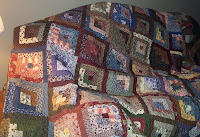 A friend who has arthritis in his hand wanted a new small carving knife for carving details in cottonwood bark. I decided to use a small knife blade made from small pen file. I felt that a larger, fatter handle would be more comfortable for my friend. Here is the step-by-step process that I went through. The first photo is of the knife made from a pen file.
A friend who has arthritis in his hand wanted a new small carving knife for carving details in cottonwood bark. I decided to use a small knife blade made from small pen file. I felt that a larger, fatter handle would be more comfortable for my friend. Here is the step-by-step process that I went through. The first photo is of the knife made from a pen file. This photo is of the blade and a drill bit. Notice that the drill bit diameter is a little larger than the knife shank.
This photo is of the blade and a drill bit. Notice that the drill bit diameter is a little larger than the knife shank. I selected a piece of walnut for the handle. I made a pattern of the handle profile, and traced the pattern on the walnut blank. The handle is ready to cut out.
I selected a piece of walnut for the handle. I made a pattern of the handle profile, and traced the pattern on the walnut blank. The handle is ready to cut out. Cut out the handle, but leave a flat bottom at the end of the handle. Set the handle blank on a flat surface, locate the center of the blade end of the blank. At the marked center, drill the hole to accept the knife blade shank.
Cut out the handle, but leave a flat bottom at the end of the handle. Set the handle blank on a flat surface, locate the center of the blade end of the blank. At the marked center, drill the hole to accept the knife blade shank. Without the blade in the handle, rough shape the handle. I use a drum sander in a rotary tool.
Without the blade in the handle, rough shape the handle. I use a drum sander in a rotary tool. Wrap the handle and the cutting end of the knife blade with masking tape. This will protect the wood and the cutting surface of the knife from the epoxy. Mix up the epoxy and put come into the hole in the handle. Roll the knife blade shank in the epoxy and push it into the hole. Position and align the blade and let cure.
Wrap the handle and the cutting end of the knife blade with masking tape. This will protect the wood and the cutting surface of the knife from the epoxy. Mix up the epoxy and put come into the hole in the handle. Roll the knife blade shank in the epoxy and push it into the hole. Position and align the blade and let cure. After the epoxy has cured, remove the masking tape and finish sand the handle. Apply any type of finish you want.
After the epoxy has cured, remove the masking tape and finish sand the handle. Apply any type of finish you want.The idea here was to create a detail carving knife that would be more comfortable to use, when your hands might be tired or sore. I think carving with the fatter handled knife after using smaller ones will achieve the goal.





.JPG)

























